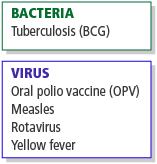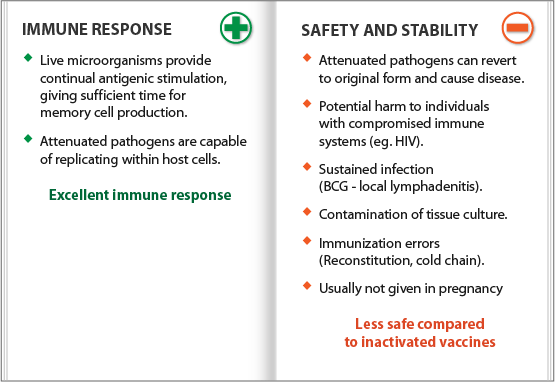Live attenuated vaccines (LAV)

Available since the 1950s, live attenuated vaccines (LAV)![]() Live attenuated vaccine (LAV)A vaccine prepared from living micro-organisms (viruses, bacteria currently available) that have been weakened under laboratory conditions. LAV vaccines will replicate in a vaccinated individual and produce an immune response but usually cause mild or no disease. are derived from disease-causing pathogens
Live attenuated vaccine (LAV)A vaccine prepared from living micro-organisms (viruses, bacteria currently available) that have been weakened under laboratory conditions. LAV vaccines will replicate in a vaccinated individual and produce an immune response but usually cause mild or no disease. are derived from disease-causing pathogens![]() PathogenAny disease-causing substance. Most commonly used for organisms (e.g., bacteria, viruses) and their biological products (e.g. toxins). (virus
PathogenAny disease-causing substance. Most commonly used for organisms (e.g., bacteria, viruses) and their biological products (e.g. toxins). (virus![]() VirusAn ultramicroscopic infectious agent that consists of genetic material surrounded by a protein coat. A virus can replicate themselves only within cells of living hosts. or bacteria
VirusAn ultramicroscopic infectious agent that consists of genetic material surrounded by a protein coat. A virus can replicate themselves only within cells of living hosts. or bacteria![]() BacteriaSingle-celled life-forms that can reproduce quickly on their own. Some bacteria cause disease.) that have been weakened under laboratory conditions. They will grow in a vaccinated individual, but because they are weak, they will cause no or very mild disease.
BacteriaSingle-celled life-forms that can reproduce quickly on their own. Some bacteria cause disease.) that have been weakened under laboratory conditions. They will grow in a vaccinated individual, but because they are weak, they will cause no or very mild disease.
Immune response
LAVs stimulate an excellent immune response![]() Immune responseThe body's defense against foreign objects or organisms, such as bacteria, viruses or transplanted organs or tissue. that is nearly as good as compared to an infection with the wild-type pathogen.
Immune responseThe body's defense against foreign objects or organisms, such as bacteria, viruses or transplanted organs or tissue. that is nearly as good as compared to an infection with the wild-type pathogen.
Live microorganisms![]() MicroorganismsTiny organisms (including bacteria and viruses) that can only be seen with a microscope. provide continual antigenic stimulation giving sufficient time for memory cell production.
MicroorganismsTiny organisms (including bacteria and viruses) that can only be seen with a microscope. provide continual antigenic stimulation giving sufficient time for memory cell production.
In the case of viruses or intracellular microorganisms where cell-mediated immunity![]() Cell-mediated immunityAn immune response not involving antibodies, in which specific blood cells, leukocytes, and lymphocytes attack and remove antigens. is usually desired, attenuated pathogens are capable of replicating within host cells.
Cell-mediated immunityAn immune response not involving antibodies, in which specific blood cells, leukocytes, and lymphocytes attack and remove antigens. is usually desired, attenuated pathogens are capable of replicating within host cells.
Safety and stability
Since LAVs contain living organisms, there is a degree of unpredictability raising some safety and stability concerns.
- Attenuated pathogens have the very rare potential to revert to a pathogenic form and cause disease in vaccinees or their contacts. Examples for this are the very rare, serious adverse events of:
- vaccine-associated paralytic poliomyelitis (VAPP) and
- disease-causing vaccine-derived poliovirus (VDPV) associated with oral polio vaccine (OPV).
- Functional immune systems eliminate attenuated pathogens in their immune response. Individuals with compromised immune systems, such as HIV-infected patients may not be able to respond adequately to the attenuated antigens.
- Sustained infection, for example tuberculosis (BCG) vaccination can result in local lymphadenitis or a disseminated infection.
- If the vaccine is grown in a contaminated tissue culture it can be contaminated by other viruses (e.g. retro viruses with measles vaccine).
- As a precaution, LAVs tend not to be administered during pregnancy. However, the actual potential for fetal damage remains theoretical. For example, numerous studies have demonstrated that accidental rubella vaccination during pregnancy did not result in an increased risk of birth defects.
- LAVs can have increased potential for immunization errors:
- Some LAVs come in lyophilized (powder) form. They must be reconstituted with a specific diluent before administration, which carries the potential for programmatic errors if the wrong diluent or a drug is used.
- Many LAVs require strict attention to the cold chain for the vaccine to be active and are subject to program failure when this is not adhered to.

Adverse reactions associated with LAVs
Five vaccines that are recommended by WHO are produced using LAV technology which are displayed in the table below:
- Tuberculosis (BCG),
- Oral Polio Vaccine,
- Measles,
- Rotavirus,
- Yellow Fever.
The table lists the rare, more severe adverse reactions of these vaccines. Note the frequency of the adverse reactions to get an idea of how low or high the possibility of an adverse event is. Also read the Comments to understand additional context details on the adverse events.
Five WHO recommended vaccines using LAV technology
Question
Which of the following statements is correct (Several answers possible)
| A. Febrile seizures are an uncommon reaction to vaccination with measles. | |
| B. Compared to giving the first dose of measles vaccine, allergic reactions are less likely to occur during the second dose of measles vaccine. | |
| C. Live vaccines include BCG, Measles, Rotavirus, Pertussis vaccine and Yellow fever vaccine. | |
| D. Vaccine associated paralytic poliomyelitis occurs very rarely among vaccines (2 – 4 cases per 1,000,000 vaccinated persons). |
Answers A and D are correct.
Answer B: Allergic anaphylactic reactions are more likely to occur after receipt of the second dose of measles vaccine.
Answer C: Pertussis (wP) is an inactivated vaccine. Live vaccines include:
- Tuberculosis (BCG)
- Oral Polio Vaccine,
- Measle,
- Rotavirus,
- Yellow Fever.



